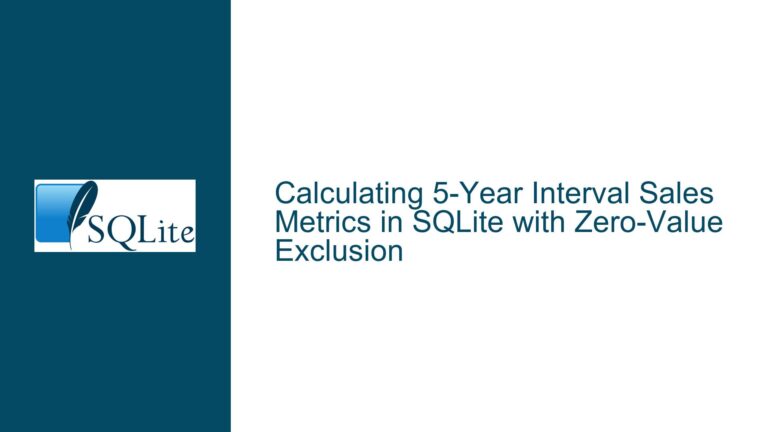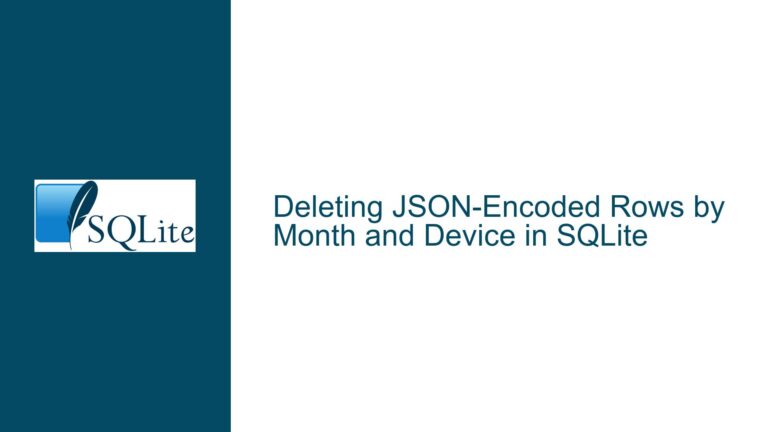SQLite Floating-Point Precision Issues in > Queries
Understanding Floating-Point Precision in SQLite Queries
When working with SQLite, one of the most common yet misunderstood issues revolves around floating-point precision, especially when dealing with comparison operators such as the greater-than (>) operator. The core of the problem lies in how SQLite, like many other database systems, handles floating-point numbers under the hood. SQLite uses 64-bit IEEE-754 floating-point numbers to store real numbers, which inherently introduces precision limitations. These limitations become particularly noticeable when dealing with very large or very small numbers, or when performing comparisons that require high precision.
In the context of the issue described, the user is querying a table named logdata with a column Time_ms that stores timestamps as floating-point numbers. The query SELECT Time_ms FROM logdata WHERE Time_ms > 45466707900.2508 is expected to return rows where the Time_ms value is strictly greater than 45466707900.2508. However, the result includes the exact value 45466707900.2508, which contradicts the query’s condition. This behavior is not a bug but rather a manifestation of the inherent limitations of floating-point arithmetic.
To fully grasp why this happens, it’s essential to understand how floating-point numbers are represented in memory. A 64-bit IEEE-754 floating-point number, also known as a double-precision floating-point number, consists of three parts: the sign bit, the exponent, and the mantissa (also called the significand). The mantissa is where the actual digits of the number are stored, and it has a finite size, which limits the precision of the number. Specifically, a 64-bit floating-point number can accurately represent about 15 to 17 decimal digits. Beyond this limit, the representation becomes approximate, leading to rounding errors.
In the case of the query SELECT Time_ms FROM logdata WHERE Time_ms > 45466707900.2508, the value 45466707900.2508 is already at the edge of the precision limit for a 64-bit floating-point number. When SQLite compares this value with the values in the Time_ms column, it may not distinguish between 45466707900.2508 and 45466707900.250836 due to the rounding errors introduced by the floating-point representation. As a result, the query incorrectly includes the row with the value 45466707900.2508 in the results.
This issue is further compounded when the user attempts to exclude the value using the inequality operator (!=). The query SELECT Time_ms FROM logdata WHERE Time_ms != 45466707900.250836 still includes the value 45466707900.2508 in the results because, from SQLite’s perspective, these two values are effectively the same due to the precision limitations.
The Impact of IEEE-754 Floating-Point Representation on SQLite Queries
The IEEE-754 floating-point representation is a standardized method for representing real numbers in binary form. While this representation is efficient and widely used, it comes with certain trade-offs, particularly in terms of precision. In SQLite, these trade-offs can lead to unexpected behavior in queries involving floating-point numbers, especially when performing comparisons.
One of the key characteristics of IEEE-754 floating-point numbers is that they are not exact representations of real numbers. Instead, they are approximations. This approximation is necessary because there are infinitely many real numbers, but only a finite number of bits available to represent them. As a result, some real numbers cannot be represented exactly, and rounding errors occur. These rounding errors can accumulate over multiple operations, leading to significant discrepancies in the results.
In the context of SQLite queries, these rounding errors can cause unexpected results when comparing floating-point numbers. For example, consider the value 45466707900.2508. When this value is stored as a 64-bit floating-point number, it is approximated to the nearest representable value. This approximation may introduce a small error, making the stored value slightly different from the original value. When SQLite compares this stored value with another floating-point number, it uses the approximated value, which may not match the expected result.
The issue becomes more pronounced when dealing with very large or very small numbers. As the magnitude of the number increases, the distance between representable floating-point numbers also increases. This means that for very large numbers, the rounding errors can be substantial, making it difficult to perform precise comparisons. In the case of the Time_ms column, the values are large timestamps, which are particularly susceptible to these precision issues.
Another factor that exacerbates the problem is the way SQLite handles floating-point comparisons. SQLite uses a binary comparison for floating-point numbers, which means it compares the binary representation of the numbers rather than their decimal values. This binary comparison can lead to unexpected results when the numbers are very close to each other but not exactly equal due to rounding errors. For example, the binary representation of 45466707900.2508 may be indistinguishable from the binary representation of 45466707900.250836 due to the limited precision of the floating-point format.
Strategies for Mitigating Floating-Point Precision Issues in SQLite
Given the inherent limitations of floating-point arithmetic, it’s essential to adopt strategies that mitigate precision issues in SQLite queries. One of the most effective strategies is to avoid using floating-point numbers for values that require high precision, such as timestamps. Instead, consider using integer types, which provide exact representations and avoid the rounding errors associated with floating-point numbers.
In the case of the Time_ms column, storing timestamps as integers can significantly improve the accuracy of comparisons. For example, instead of storing the timestamp as 45466707900.2508, you could store it as 454667079002508, representing the timestamp in nanoseconds. This approach eliminates the need for floating-point arithmetic and ensures that comparisons are performed with exact values.
Another strategy is to use a fixed-point representation for values that require high precision. Fixed-point numbers are stored as integers but are interpreted as having a fixed number of decimal places. For example, you could store the timestamp as 454667079002508 and interpret it as 45466707900.2508 by dividing the value by 10^4 when retrieving it. This approach provides the precision of integers while allowing for decimal places.
When working with floating-point numbers, it’s also important to be aware of the precision limitations and design your queries accordingly. For example, instead of using the greater-than (>) operator, you could use a range-based comparison that accounts for potential rounding errors. For instance, instead of SELECT Time_ms FROM logdata WHERE Time_ms > 45466707900.2508, you could use SELECT Time_ms FROM logdata WHERE Time_ms > 45466707900.2508 + epsilon, where epsilon is a small value that accounts for the precision limitations.
Additionally, consider using the ROUND function to round floating-point numbers to a specific number of decimal places before performing comparisons. This can help reduce the impact of rounding errors and ensure that comparisons are performed on consistent values. For example, you could use SELECT Time_ms FROM logdata WHERE ROUND(Time_ms, 4) > 45466707900.2508 to round the Time_ms values to four decimal places before comparing them.
Finally, when designing your database schema, carefully consider the data types for each column. Choose data types that provide the necessary precision for your application and avoid using floating-point numbers for values that require exact representations. By understanding the limitations of floating-point arithmetic and adopting appropriate strategies, you can mitigate precision issues in SQLite queries and ensure accurate and reliable results.
Conclusion
Floating-point precision issues in SQLite queries are a common challenge that arises from the inherent limitations of the IEEE-754 floating-point representation. These issues are particularly noticeable when dealing with large or small numbers, or when performing comparisons that require high precision. By understanding the underlying causes of these issues and adopting appropriate strategies, such as using integer types, fixed-point representations, and range-based comparisons, you can mitigate precision issues and ensure accurate and reliable results in your SQLite queries.






